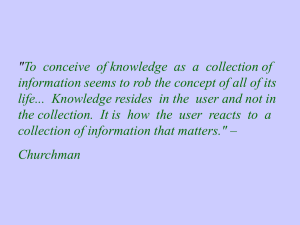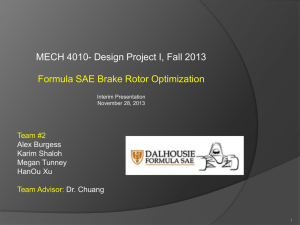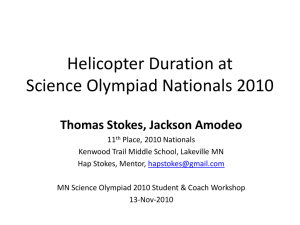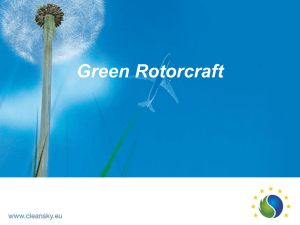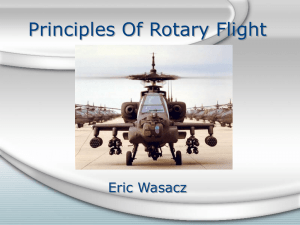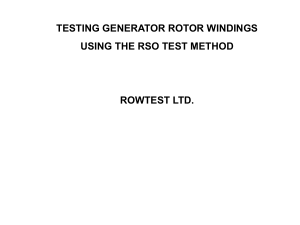IDETC2012 Presentati..
advertisement
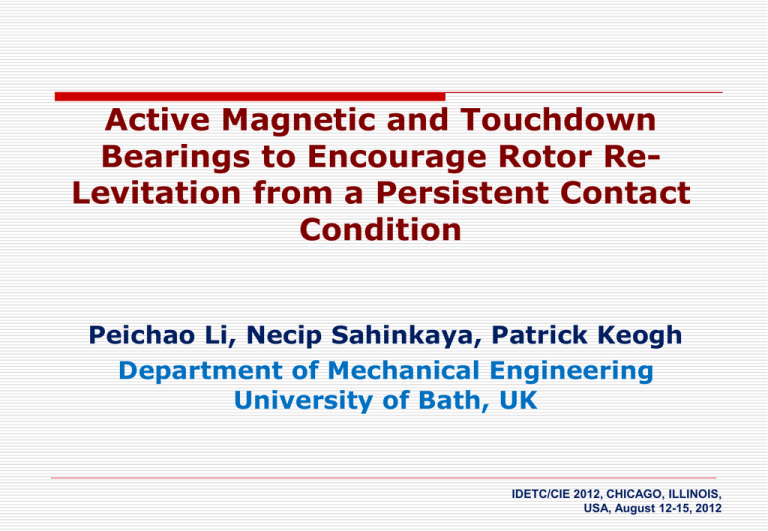
Active Magnetic and Touchdown Bearings to Encourage Rotor ReLevitation from a Persistent Contact Condition Peichao Li, Necip Sahinkaya, Patrick Keogh Department of Mechanical Engineering University of Bath, UK IDETC/CIE 2012, CHICAGO, ILLINOIS, USA, August 12-15, 2012 Background Active Magnetic Bearings (AMBs) have Touchdown Bearings (TDBs) for protection Rotor will have residual unbalance At certain operating speeds, continuous contact between rotor and TDB might be induced by external disturbances High contact forces could cause damage through induced heat dissipation at high speeds Can AMB control and active TDB control be used to achieve contact-free levitation? IDETC/CIE 2012, CHICAGO, ILLINOIS, USA, August 12-15, 2012 System Description Two active magnetic bearings (AMBs) Two active touchdown bearings (TDBs) TDBs may be moved by piezoelectric stack actuators pushing hydraulic pistons Rotor: 800 mm long, 30 mm in diameter First flexural rotor mode around 840 rad/s Disk 1 TDB A AMB A Piston IDETC/CIE 2012, CHICAGO, ILLINOIS, USA, August 12-15, 2012 Active Bearings AMB force capacity 700 N Radial clearance 0.8 mm Active TDB force capacity 10,000 N (piezo stack) Radial clearance 0.4 mm IDETC/CIE 2012, CHICAGO, ILLINOIS, USA, August 12-15, 2012 Active TDB Positioned outboard of AMB for better protection Piezoelectric Hydraulic lines limit actuation bandwidth Two eddy current position sensors were used to measure the x, y position of the TDB Rotor f c ( xr , y r ) Hydraulic coupling fc xc ( xb , yb ) Touchdown Bearing TDB TDB yc IDETC/CIE 2012, CHICAGO, ILLINOIS, USA, August 12-15, 2012 System Model - Rotor Rotor displacement equation of motion: r Cq r K qr fu fd Bm fm Bt fc Mq Rotor displacement vector Magnetic bearing force vector Unbalance force vector Contact force vector Disturbance vector No base motion is considered here IDETC/CIE 2012, CHICAGO, ILLINOIS, USA, August 12-15, 2012 System Model - TDB TDB equation of motion: t Ct q t Kt qt ft,n μ ft,t fat Mt q Touchdown bearing displacement vector Normal contact force vector Tangential contact force vector Actuation force vector The contact forces (normal, tangential friction) acting on the rotor and TDB are equal, but in opposite directions IDETC/CIE 2012, CHICAGO, ILLINOIS, USA, August 12-15, 2012 Rotor Radial Displacement Without Contact Unbalance force acting on Disk 1 (left) Predicted slow run-up radial displacement at TDB A (left) Assuming TDB removed Highest displacement occurs at around 840 rad/s, which matches the first flexible mode IDETC/CIE 2012, CHICAGO, ILLINOIS, USA, August 12-15, 2012 Rotor Radial Displacement With Contact Same unbalance on Disk 1 Rotor operating speed slowly increased from 740 rad/s to 940 rad/s, then decreased to 740 rad/s Rotor makes contact with the TDB A as speed increases Without TDB limit, rotor radial displacement decreases at speed higher than 840 rad/s Different rotor dynamics with and without contact IDETC/CIE 2012, CHICAGO, ILLINOIS, USA, August 12-15, 2012 Rotor Radial Displacement With and Without Contact The rotor dynamics change when contact occurs, at speeds above the critical operating speed The rotor radial displacement increases with speed when it is in contact Rotor radial displacement decreases when not in contact Two stable orbits With contact Without contact Control is designed to bring rotor from contact orbit to a non-contact orbit x 10 -4 With contact Without contact 6 Displacement (m) 7 5 4 3 2 1 0 750 800 850 Speed (rad/s) 900 IDETC/CIE 2012, CHICAGO, ILLINOIS, USA, August 12-15, 2012 Using an AMB to Compensate the Unbalance Force x 10 -4 Rotor Touchdown Bearing 5 Displacement (m) Rotor operating speed 840 rad/s Unbalance only on Disk 1 (left) Synchronous compensation force was calculated* by using noncontact data. The synchronous force was applied to the rotor through AMBs at 1.5 s AMB force is limited, hence for larger unbalance the procedure may not be possible Could affect the orbit at other points along the shaft, hence further contacts could be induced 3 2 1 0 1 1.2 1.4 1.6 Time (s) 1.8 2 1.4 1.6 Time (s) 1.8 2 1800 1600 1400 Contact Force (N) 4 1200 1000 800 600 400 200 * Royal Society of London Paper (1983) IDETC/CIE 2012, CHICAGO, ILLINOIS, USA, August 12-15, 2012 0 1 1.2 Using an AMB to Compensate the Unbalance Force IDETC/CIE 2012, CHICAGO, ILLINOIS, USA, August 12-15, 2012 Using TDB Motion to Release the Entrapped Rotor 6 Rotor operating speed 940 rad/s Single unbalance on Disk 1 Disturbance force of 600 N was applied at 1.2 s, lasting for 0.08 s TDB moves in the same direction as the rotor The radial TDB displacement was limited to 0.1 mm IDETC/CIE 2012, CHICAGO, ILLINOIS, USA, August 12-15, 2012 4 3 2 0 1 Rotor makes contact with the TDB A (left) High contact force TDB A motion was applied at 1.5 s Rotor Touchdown Bearing 1 1.2 1.4 1.6 Time (s) 1.8 2 1.2 1.4 1.6 Time (s) 1.8 2 4500 4000 3500 Contact Force (N) -4 5 Displacement (m) x 10 3000 2500 2000 1500 1000 500 0 1 Using TDB Motion to Release the Entrapped Rotor IDETC/CIE 2012, CHICAGO, ILLINOIS, USA, August 12-15, 2012 TDB Control with Symmetric Unbalance Rotor operating speed Unbalance mass on Disks 1, 2 and 3 Disturbance was applied on the middle of the shaft for 0.1 s Not able to release the entrapped rotor Increased rotor contact orbit Rotor Touchdown Bearing 5 4 3 TDB A 2 0 1 7 x 10 1.2 1.4 1.6 Time (s) 1.8 2 -4 Rotor Touchdown Bearing 6 5 4 3 TDB B 2 1 0 1 IDETC/CIE 2012, CHICAGO, ILLINOIS, USA, August 12-15, 2012 -4 1 Rotor makes continuous contact after the disturbance The same motion was applied at the same time for both TDBs Displacement (m) 940 rad/s x 10 6 Displacement (m) 7 1.2 1.4 1.6 Time (s) 1.8 2 TDB Control with Symmetric Unbalance IDETC/CIE 2012, CHICAGO, ILLINOIS, USA, August 12-15, 2012 TDB Control with Symmetric Unbalance 7 x 10 -4 Rotor Touchdown Bearing Same operating parameters Motion control on TDBs were applied at different times 4 TDB A 3 2 0 1 TDB A at 1.7 s TDB B at 2 s More effective than applying the motion control on TDBs at the same time 5 1 7 1.2 x 10 1.4 1.6 Time (s) 1.8 2 -4 Rotor Touchdown Bearing 6 Displacement (m) Displacement (m) 6 5 4 TDB B 3 2 1 0 1 IDETC/CIE 2012, CHICAGO, ILLINOIS, USA, August 12-15, 2012 1.2 1.4 1.6 Time (s) 1.8 2 TDB Control with Symmetric Unbalance IDETC/CIE 2012, CHICAGO, ILLINOIS, USA, August 12-15, 2012 Conclusions Residual rotor unbalance always exists: Disturbances could initiate rotor/TDB contact and change the rotor dynamics Either synchronous AMB forces or TDB motion control can be effective in restoring contact-free levitation when the rotor has localized unbalance With distributed unbalance: Simultaneous TDB motion may be ineffective, but sequenced TDB motion control may restore contact-free rotor levitation Understanding of the contact rotor dynamics is required: Non-linear characteristics can lead to differing rotor responses causes by control actions that differ in sequencing only IDETC/CIE 2012, CHICAGO, ILLINOIS, USA, August 12-15, 2012
